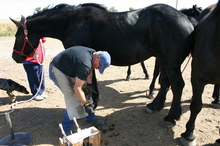In the USA, most states do not have a licensing program for farriers, so a wide quality gap may occur among practicing farriers in many areas. The American Farriers Association is active in many states and members in good standing must meet certain requirements.

The work of a farrier
Effective training to become a farrier is not easy or soft in any way and includes working with horses under all kinds of conditions whether in the hot weather of August or the cold snowy conditions of February.
Many farriers initially get into the business because of their love of horses and being around them. They volunteer at veterinarians' practices, and often assist farriers as they begin learning the skills necessary to become a farrier. For well-trained farriers the process is one of volunteering, going to school, and hard-knock training as they learn all about horse hoof and leg anatomy, conformation, diagnosis of limb and hoof conditions, trimming, shoeing, and what it takes to be a farrier.
A number of specialized schools for farriers exist and these schools train farriers, not only in how to shoe a horse, but also in anatomy, physiology, horse psychology, and how to deal with a diverse range of ailments. Classroom study is followed by practical experience in diagnosing limb and hoof conditions, forging horse shoes, trimming hooves and nailing shoes to the hooves of numerous horses.
By the time farrier students finish the necessary courses and pass the final examinations, they will have observed experienced farriers working with a number of horses and will have diagnosed and treated injuries and conditions related to horse's limbs and hooves under the supervision of both skilled farriers and veterinarians.
In addition, they will most likely have shod hundreds of horses with all kinds of hooves, many that necessitate forging specialized horse shoes and doing other customized specialty work. They will have worked in all kinds of conditions spending hours bending over and lifting horse's feet as they diagnose, treat, and shoe horses.
Some farriers gain their knowledge and skills by working as an apprentice with a skilled farrier. These apprenticeships may last for several months or for years depending on the background the student farrier brings to the training.
Effective training to become a farrier is not easy or soft in any way. Actual experience working with horses under all kinds of conditions is necessary whether it is in the hot weather of August or the cold snowy conditions of February.
Acquiring the skills a farrier needs to be successful in diagnosing all kinds of limb and hoof problems, trimming and balancing hooves, choosing the best kinds of horse shoes for the particular horse and devising corrective measures where necessary is a time-consuming and difficult process.
In addition, a farrier needs to constantly up-date both knowledge and skills according to the new developments in the science of working with horse's limbs and hooves. As with veterinarians, a good farrier will welcome opportunities to advance their expertise by taking classes and becoming members in associations and organizations promoting advancement in good horse care.
An experienced farrier will have sound background knowledge of the practice of the craft along with experience in shoeing all types of hooves, making shoes to fit all types of horses and working conditions, and also will be skilled in developing treatments to compensate for faulty limb action or form.
